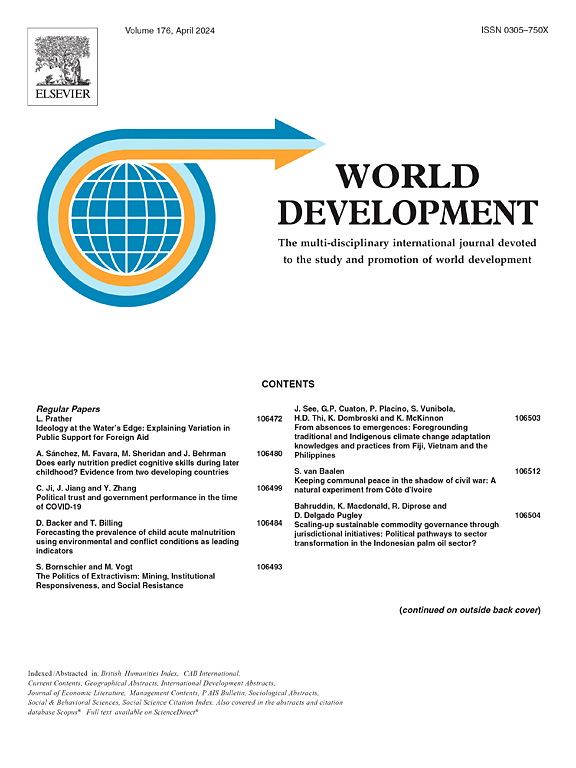抵消缓慢的暴力:哥伦比亚反颠覆首都的保护、流离失所和(Im)流动性
IF 5.4
1区 经济学
Q1 DEVELOPMENT STUDIES
引用次数: 0
摘要
学者和社区长期以来一直认为,在武装冲突背景下,历史战争过程、国家形成和积累与自然保护的必要性重叠,保护引起的不公正现象会恶化。本文通过展示保护和暴力之间相互加强的关系如何通过普通的、通常被视为理所当然的、不那么戏剧性的排斥形式被空间化,为这些分析做出了贡献。在哥伦比亚波亚acacpuerto的Serranía de las Quinchas地区(该地区在该国的武装冲突中发挥了关键作用),我分析了保护和暴力交织在一起如何改变了人们的日常流离失所和流动制度。本研究中的民族志和档案研究描述了农民的流动性和空间制造项目,以及他们如何随着与森林砍伐焦虑和生物多样性丧失、武装控制以及当今形式的环境抵消和新自由主义保护计划相关的发展和科学叙述的出现而逐渐转变。这项研究强调了世俗的、性别化的空间是如何随着自然保护的缓慢暴力的领地化而发生变化的。关于绿色掠夺的文献经常强调戏剧性的、由保护引起的迁移;然而,在昆查斯,由于保护和暴力而产生的不公正的空间安排嵌入了新的日常流动中,重塑了当地的农民生活项目。这一过程在性质上不同于有充分记录的堡垒和军事化保护的情况。具体来说,女性的日常活动受到限制,有利于更好的保护成果、环境抵消项目和非人类邻居的流动。这种不动性与campesino空间制造项目特有的动态历史流动性形成鲜明对比。在围绕公正和愉快的保护的新辩论和建议中,本文对保护看似良性的时间性、圈地性和日常地理所带来的微妙、潜在的风险持谨慎态度,这些风险可能被学者和保护实践者所忽视。本文章由计算机程序翻译,如有差异,请以英文原文为准。
Offsetting slow violence: Conservation, displacement and (Im)mobility at the anti-subversive capital of Colombia
Scholars and communities have long argued that conservation-induced injustices worsen in armed conflict contexts, where historical warfare processes, state formation, and accumulation overlap with the imperatives of nature preservation. This paper contributes to these analyses by showing how the mutually reinforcing relationship between conservation and violence is spatialized through ordinary, often taken-for-granted, less dramatic forms of exclusion. Focusing on the Serranía de las Quinchas in Puerto Boyacá, Colombia, a region that played a critical role in the country’s armed conflict, I analyze how people’s everyday displacements and mobility regimes were transformed as a result of the entwined repertoires of conservation and violence. Ethnographic and archival research in this study describes the mobilities and space-making projects of campesinos colonos, and how they were gradually transformed with the emergence of development and scientific narratives related to deforestation anxiety and biodiversity loss, armed control, and present-day forms of environmental offsetting and neoliberal conservation schemes. The study highlights how mundane, gendered spatialities shifted with the territorialization of conservation’s slow violence. The literature on green grabbing often emphasizes dramatic, conservation-induced displacements; in Quinchas, however, the unjust spatial arrangements arising from conservation and violence are embedded in new, everyday mobilities that reshape local campesino life projects. This process is qualitatively distinct from the well-documented scenarios of fortress and militarized conservation. Specifically, women’s everyday mobilities have been restricted in favor of better conservation outcomes, environmental offsetting projects, and the mobility of non-human neighbors. This immobility starkly contrasts with the dynamic historical mobilities unique to campesino space-making projects. Amidst renewed debates and proposals around just and convivial conservation, this paper is cautious of the subtle, insidious risks posed by conservation’s seemingly benign temporalities, enclosures, and everyday geographies that scholars and conservation practitioners might overlook.
求助全文
通过发布文献求助,成功后即可免费获取论文全文。
去求助
来源期刊

World Development
Multiple-
CiteScore
12.70
自引率
5.80%
发文量
320
期刊介绍:
World Development is a multi-disciplinary monthly journal of development studies. It seeks to explore ways of improving standards of living, and the human condition generally, by examining potential solutions to problems such as: poverty, unemployment, malnutrition, disease, lack of shelter, environmental degradation, inadequate scientific and technological resources, trade and payments imbalances, international debt, gender and ethnic discrimination, militarism and civil conflict, and lack of popular participation in economic and political life. Contributions offer constructive ideas and analysis, and highlight the lessons to be learned from the experiences of different nations, societies, and economies.
 求助内容:
求助内容: 应助结果提醒方式:
应助结果提醒方式:


